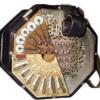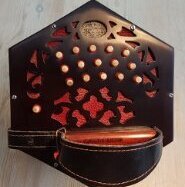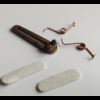-
Posts
1,855 -
Joined
-
Last visited
About d.elliott
- Birthday 08/08/1950
Contact Methods
-
Website URL
http://www.concertina-repair.org.uk
Profile Information
-
Gender
Male
-
Interests
ENGLISH System: including: Bass; Baritone; Treble; Miniature, some Anglo
All forms of Concertina playing, but also Repair and Restoration of traditional instruments (all systems). like to provide help & assistance as needed. Author of 'Concertina Maintenance Manual'
I give talks and run workshops on repair and restoration
West Gallery Singing & Shape Note Singing
Traditional Music, Concertina Band Playing -
Location
Oughtibridge, Sheffield, South Yorkshire, England
Recent Profile Visitors
d.elliott's Achievements

Heavyweight Boxer (5/6)
-

Interesting notes on "Old Pitch" in concertinas
d.elliott replied to Matthew Heumann's topic in General Concertina Discussion
The 'descendant company ' that made the tuning forks is still in existence in Sheffield. -

Troubleshooting leaky action box
d.elliott replied to RogerT's topic in Instrument Construction & Repair
Hope it works for you. -

Troubleshooting leaky action box
d.elliott replied to RogerT's topic in Instrument Construction & Repair
This is where most people start, innovative, but does not actually help much, I find that a bright light shone from under the pad board will give you much more to consider. look around each pad, check the springs for any that are soft and look at the split in the pad board. The split can give three separate issues: an air path between one or more pads an air path under where the pads seal a discontinuity in 'level' providing leakage between chambers. -
Wheatstone's offered four pitches as standard on their price lists, One was 'Continental Pitch' where 'C' is 517.3 Hz. This equates to A= 435Hz.. at A4 1 Hz = circa 4 cents, so this would be 20 cents flat to A=440Hz. I would suggest that the OP has/ had a concertina in it's original 'Continental' pitch. This pitch was established through French Regulations in 1859 and was known as :“Diapason Normal”
-

Double-extended EC what would you call it?
d.elliott replied to Matthew Heumann's topic in General Concertina Discussion
Don't forget that the anomaly is the expression 'Tenor Treble'. by rights it should have been termed a 'Treble-Tenor' as it is a treble extended down through the Tenor range. There were a few Tenor instruments made that had the low 'C' on the Left hand side. I suppose that some might think of them as a short baritone? -

How do you make reeds louder or softer?
d.elliott replied to Matthew Heumann's topic in Instrument Construction & Repair
Are all the reeds with the same reed tongue metal? -

Double-extended EC what would you call it?
d.elliott replied to Matthew Heumann's topic in General Concertina Discussion
If the thumb strap centre lines are positioned opposite the note key centre lines as for a standard treble (C on Left and D on right), then it is a treble, extended up and down to baritone range. If the keys straps are set for a treble then it is not a baritone, which is a transposing instrument and has it's straps set for the C & D one octave lower.. The scale shown in your picture is not a full octave down, it is the tenor range, and upwards so the 'Baritone' label does not apply. -

Original valves glued “in reverse”
d.elliott replied to rcr27's topic in Instrument Construction & Repair
I saw that too, this notching is not uncommon where the vent is close to the chamber wall. The situation that I refer to is when the chamber wall distorts leaning over towards the adjacent valve, sometimes pushed by the clamp & screws of the reed beside the wall. -

Original valves glued “in reverse”
d.elliott replied to rcr27's topic in Instrument Construction & Repair
I have also seen this technique used where the chamber walls have developed a lean over the valve' 'air space' there is usually more clearance near the root of the reed. Of course there is the potential of a penalty in reed responsivness. -
The ebonised concertina appears to utilise brass reed frames, the metal ended instrument Aluminium reed frames. there will be a weight difference, as was intended.
-
The raised end was supposed to provide a better sound 'projection' and as such was a more expensive option on the better instruments. I have never been convinced that it makes any real difference, other than to add to price and these days, saleability.
-
To make a Jeffries duet, I think you would need to get a full replacement set of reed blocks, and then make sure that the ones you get will fit on the chambers (by waxing), The chambers are rectangular holes cut into wood, probably by laser, I did not dismount a reed block to check.










